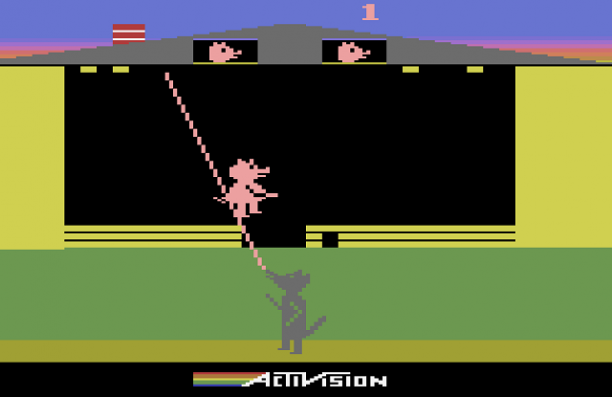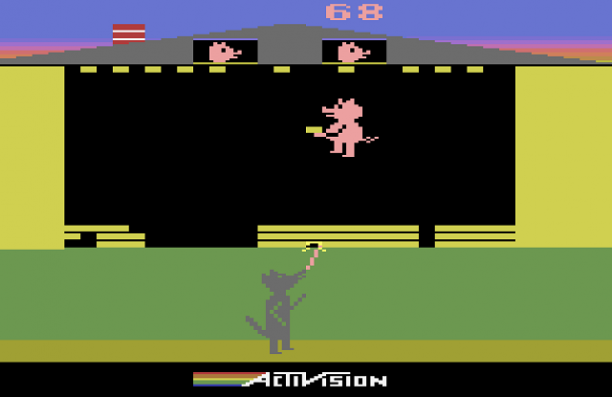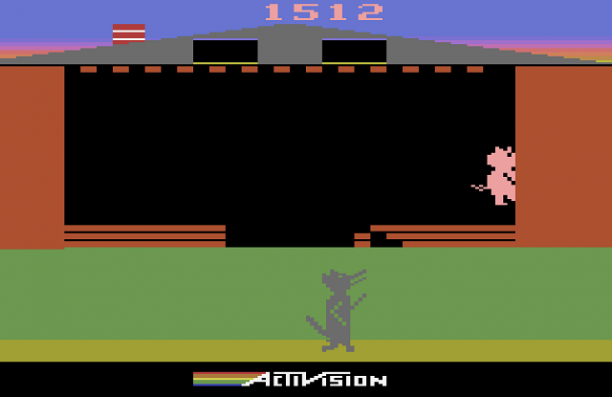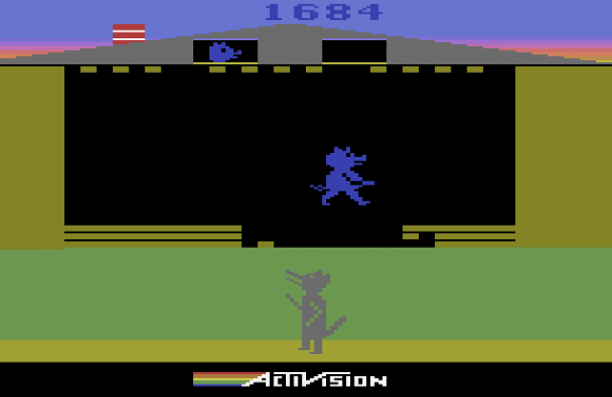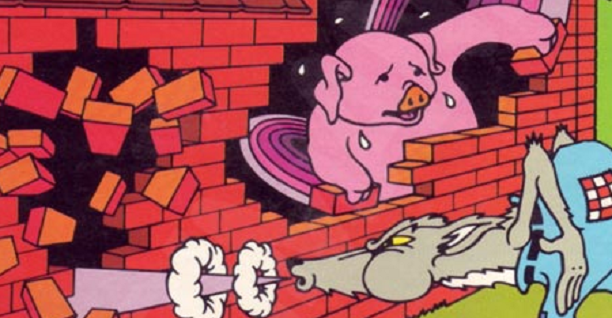
Pixel Gallery
Oink!
Retro Platforms: Atari 2600
Platform Reviewed: Atari 2600
Perhaps one of the less remembered fables is the classic Three Little Pigs, a story that has the apparent moral of being prepared for the deadliest of situations. The plot is simple: three sibling pigs are sent out into the wild in order to amass riches, with their first steps naturally being to construct homes for shelter. One pig builds his house out of straw, another one creates his home out of sticks, and only the third pig is logical enough to make his shelter out of bricks. As a result of this, the first two pigs tragically have their homes blown down by a wolf before being eaten; the third pig doesn’t suffer this fate, and instead manages to trap and eat the wolf! Oink! tells the tale somewhat differently and attempts to make the story interactive, but is its gameplay entertaining? And how elaborate can the game’s presentation be on a simple system like the Atari 2600?
Graphics
Probably the most impressive aspect of the game is its character representation, as the pigs and wolf are elaborately drawn and actually look like the creatures who they’re meant to represent: they have faces, animated limbs, tails, and shapes that impressively show us animals instead of asking us to imagine some blobs as being mammals. Both the wolf and pigs shuffle their feet around as they move, with the pigs being able to walk in all directions, and the wolf moving left and right. The wolf’s limb movements are limited to his feet, however, which is understandable considering that the wolf’s attacks don’t involve his arms, but it can seem unnatural at times; conversely, the pig additionally moves his arms as he picks up and drops blocks, giving the player clear feedback to gameplay-related actions. For an Atari 2600 game, this is pretty impressive, although the animal behavior seems robotic: there are no idle animations, and facial details never change in the slightest.
Another thing that adds life to the graphics is the game’s storytelling, which provides something beyond scoring to the presentation; it’s nothing too advanced, and each stage basically ends the same way, but the implementation is notable. Blocks are destroyed by the wolf’s laser beams, and if a pig is caught by the wolf, then there’s a slightly disturbing scene of the pig running off-screen while the wolf chases him; the implications are that the pig is killed since he never appears again, which adds some surprising ambiguity in a creepy yet intense manner. To complement the story is a barn-like setting, which has its ups and downs. On the plus side, there’s an outside-in perspective, a surrounding sunset is pleasant yet subtle, remaining lives are visually represented as pigs in windows, and there’s a visual distinction between block levels; on the negative side, the scenic depth perception feels strange, fleeing events go through walls, and other houses only vary via a single color change as opposed to layout differences. But overall, the good details outweigh the bad, and I really like the story elements!
Audio
There’s nothing to say about music because Oink! lacks any musical moments; I absolutely understand there not being a continuous track, but not even having an opening jingle feels like a missed opportunity. When the game ends via the eventual demise of all three pigs, nothing plays afterwards either; some creepy beeps might have helped intensify the moment, although I suppose one could argue that the sudden silence works for this particular case. Strong sound effect variety would help counter the lack of musical effects, but the diversity of sounds is actually rather limited, being limited to attacks, block movements, and running around; the last of these also sounds identical for both the wolf and the pigs, which feels a little uninspired. However, there are some dramatic noises: being drawn to the wolf has an alert-like impact that’s actually startling, and being caught by the wolf sounds dark despite the technical limitations. I also like the block sounds, especially how the sounds for picking up a block followed by dropping it are connected; they have an upbeat quality to them as well!
Gameplay
Although the original source material involves the last of the three pigs defeating the wolf, Oink! decides to have a darker spin on the story, as every pig will eventually die no matter how well you perform; all you can do is delay the inevitable as you earn points by rebuilding bottom walls. You control one of the three pigs at a time, being transferred to a new house with a new pig after each implied death; this is a neat narrative implementation of lives, although it’s too bad that the actual houses only change in color and not actual block layout. Now regarding these defensive structures, they’re what the entire gameplay is themed around, as blocks are your entire means of protection from the menacing wolf: three rows of equally sized and rectangular blocks serve as your shields against the wolf’s apparent laser beams; at least, that’s definitely what it looks like what the wolf is firing.
The furry villain walks left and right, making frequent chips away at your walls of defense, which you can sort of imagine as a reverse Breakout scenario. He doesn’t quite follow you constantly, but he also doesn’t deliberately avoid you for large amounts of time; the creature is additionally smart enough to stand still and remove a column of blocks in a row if you stand still. I would say that the difficulty is well-balanced, and trying to evade the wolf can sometimes be slightly intense. The most dramatic moments of the game are when lasers hit you, making you immediately drop whatever block you’re holding as you get forcefully drawn to the bottom of the screen. If you touch a block on the way down, then you’re safe; otherwise, the wolf chases you, and the next level (unless you reached the last pig) begins with a new pig. There isn’t much variety to how the wolf attacks though; after a few seconds, you’ll have seen every manner of strategy that the wolf has to offer. The wolf can also attack diagonally through some gaps, which doesn’t seem logical on a visual level, and it feels weird to defend against.
To counter these simple yet repetitive attacks, you have simple yet repetitive actions of your own: cover up holes with blocks dropped from the top of the screen, unless you’re playing on expert which requires you to manually move the blocks to the bottom of the screen. A new row of defensive blocks doesn’t spawn until you drop all the existing ones, so the game forces you to carefully think how to navigate around in the smallest amount of distance; if you end up covering holes (which are automatically filled in by one level) slower than the wolf creates them, then your smoked bacon is all but assured. Dropping blocks into holes is also the only way to earn points, and as you start in later houses or clear further rows of blocks, the point rewards increase in proportion to the wolf’s simultaneous speedups. One of the more interesting balance scenarios in Oink! is trying to decide whether to focus on making sturdier columns (filled with up to three blocks) versus going for a series of shorter stacks; the former approach gives you uninterrupted areas to work but requires risks to grab certain blocks, and the latter approach will likely delay your death but also get you hit more (leading to dropped blocks). Unfortunately, even with these occasional strategies, the core gameplay mechanics are only sometimes fun.
The biggest problem with Oink! is that despite its potential for strategic considerations, as well as its rare but dramatic face-offs, the interaction usually isn’t very entertaining, and the limited ways to earn points result in really repetitive gameplay. Because the wolf fires at an angle, he’s not a threat until several consecutive columns are totally removed, which makes initial parts of rounds slow-paced and barely interactive; unless you really want to lose by refusing to move around, all you do is carry blocks to whatever hole was just made and drop the blocks into said hole, and it isn’t until later that this activity starts feeling less like a chore. Part of this feeling might be due to the game being survival-focused instead of additionally having level-by-level goals, but even then, there are plenty of other defensive games with more complex natures to them; some such titles even let you attack back or complete secondary objectives, whereas Oink! feels limited and not nearly as exciting. It’s not the game being simple that’s a problem; it’s that the little interaction you have isn’t always compelling.
Despite the repetitive nature of the gameplay, there are at least some original ideas here, and I really feel that the game has personality with how it incorporates the fable’s story progression into an interactive format! Several alternate modes are also present, with the first being the earlier-mentioned difficulty options; while it still doesn’t change the main rules of the game, playing on expert forces you to get closer to the wolf in order to place blocks, which can slightly change up movement strategies. There are also multiple two-player modes: one has the players take turns playing against the computer for a high score, and the other has one player control a pig while the other plays as the wolf! Because points are only awarded while you play as the pig, and because both players play as pigs and the wolf an equal number of times, the latter mode has proper balance, although the wolf controls feel limited. These modes are nice additions that add some variety, but they’re not perfect.
Conclusion
Oink! is filled with some very creative ideas with regards to its presentation; the game’s adaptation of a dark fable ends up adding tension, and it also adds a clever spin to the concept of extra lives. The character models are also pretty elaborate, although their animations are somewhat limited; the houses look detailed too despite the lack of layout variety. But as for the gameplay, it’s only exciting sometimes, so this isn’t a game I can recommend buying if you want a consistently thrilling title; however, it’s not entirely absent of complexity: trying to dodge the wolf after enough home damage is made can be intense, the wolf’s speed changes over time, and there are a few balance considerations with deciding how to rebuild a house. If you’re willing to overlook some repetitive gameplay, then you might want to give Oink! a try, but that’s ultimately your call. And hey, it’s certainly unique!
